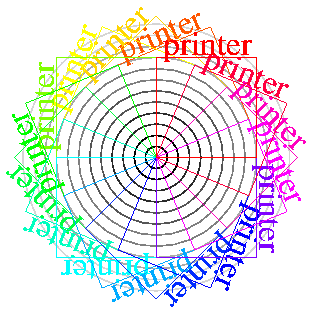
PostScript
PostScript is a graphics language invented by the people at Adobe Systems Incorporated. It is a simple stack language with a rich variety of functions. Writing graphics in this language is a joy because one can do some really cool things and because many printer devices can display it. This means that what you see on your screen will correspond to what comes out of the printer (unless there is a change of fonts). PostScript is a good way to present papers and graphics.
All PostScript documents require a PostScript viewer or must be downloaded for printing on a PostScript printer. You can get free public-domain PostScript viewers from http://www.cs.wisc.edu/~ghost/index.html.
As of 2003 Oct 15, the gv project is now hosted at sourceforge.
Once you have the viewer on your system, you should be able to show PostScript files that you download. Then you must tell your www browser how to read the postscript. In Unix, this is done with the .mailcap file. The line I use is:
application/postscript; /usr/local/gnubin/ghostview -openwindows %s
This means that my Netscape should look at /usr/local/gnubin/ghostview to run the postscript aplication, and that it should be run with the openwindows option. For more information about the mailcap file, go here.
PostScript Test File
HERE IS A SMALL
POSTSCRIPT TEST FILE. It should look like this:

PostScript Tricks
printerarea.ps is an test file that will tell you the vertical and horizontal range that a printer uses. There are 4 numbers:
llx: lower left xThey are given in points. One point is 1/72 inch. To get cm, multiply points by 2.54/72.
lly: lower left y
urx: upper right x
ury: upper right y
nouter.ps uses these 4 numbers. Make a version of nouter for your printer but replace the numbers in the code. It will display a red edge in ghostview. If any graphics touches or goes beyond the red edge, it will not appear on your printer. This can save one a lot of time!
Converting PostScript to PDF
This can be done using ghostscript. A script that does the job is called ps2pdf.
One Way to print PostScript on a Mac
1. To view a Mac PS file, get the Mac GS Viewer 1.0 at the site given above and plug it in to Netscape "application/postscript mime" in the Options/General Preferecnces/Helper. Set the "Save to Disk" feature.
2. To print the Mac PS file, go to
http://www.barebones.com/freeware.html
and download Drop*PS. Drag and drop the GS icon of the saved PS document from Step 1 above over the Drop*PS icon and it will print to a PS printer.
(Thanks to Nevin M. Summers, nevin@novation.com, for this tip! 1997 Jan 5)
Using Adobe Photoshop to Print PostScript on Macs and PCs
Delila Postscript figure files (e. g., logo, clist, map, xyout, etc.) can be nicely printed from a Macintosh or PC environment in the following manner using Adobe Photoshop. Transfer the Postscript file to the desktop machine (e. g., ftp) as a text formatted file. Name the file with the .ps suffix (e. g., filename.ps). Using Photoshop (this works at least with ver. 5.0 and 6.0), open the .ps file from the "open" menu, being sure to view "all files" or ".ps files". The file will be imported into Photoshop format with a default transparent background (checkerboard on monitor, but prints transparent). If you save the file as a Photoshop document (.psd suffix), it loads quickly into Photoshop the next time you open it. Individual Postscript images cannot be manipulated in Photoshop, although you can use "layers" and other approaches to print multiple images on the same page. My experience indicates you'll need to manipulate the Postscript output prior to export-import.
(Thanks to: Eric S. Miller, esm@unity.ncsu.edu, http://www.mbio.ncsu.edu/esm, for this tip! 2000 December 15)

Other Resources
- Internet PostScript Resources
- The program ps2ps allows one to convert postscript files in various ways. Documentation is at a location on your computer that you can find when gs is installed by "gs -h". On our system it is at: /usr/local/share/ghostscript/5.50/doc/Use.htm
- PostScript Language Document Structring Conventions Specification (Adobe Developer Support, Version 3.00 25 September 1992)
- Postscript page at the Harvard Computing/Programming Mathematics Department (well worth looking at!)
- Atchange is an automation script. You can use it to watch when you have written out a PostScript file from your favorite editor. Then atchange could pop up a ghostview for you. On my system (a Sun) the focus goes to the ghostview display. Then a simple 'q' drops me back to my editor. So I can play around with the PostScript program without having to take my hands off the keyboard!
- Mathematical illustrations: a manual of geometry and PostScript by Bill Casselman, 2005. This is a complete book!
- A good postscript introduction article
- An extensive postscript and ghostscript resource directory
- Wikibooks Postscript FAQ
Thanks to Jason Calacanis for this and the previous two pointers.


Schneider Lab.
origin: before 1996 February 14
updated: 2011 Aug 15
